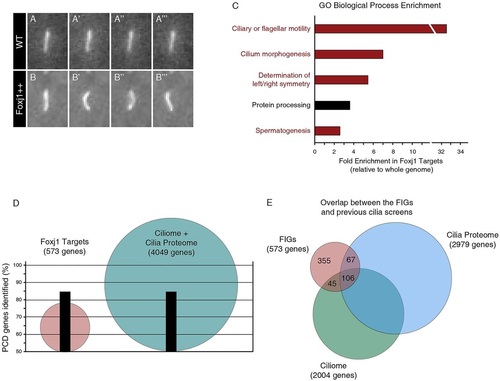Fig. 1
- ID
- ZDB-FIG-150911-18
- Publication
- Choksi et al., 2014 - Systematic discovery of novel ciliary genes through functional genomics in the zebrafish
- Other Figures
- All Figure Page
- Back to All Figure Page
|
Foxj1 upregulates known ciliogenic and ciliopathic genes. (A-B′′′) Sequential stills from movies of a Tg(actinb2::Arl13b-GFP) transgenic embryo showing (A-A′′′) an immotile primary cilium on a wild-type muscle cell (WT) and (B-B′′′) an ectopic motile cilium on a muscle cell of an Tg(actinb2::Arl13b-GFP; hsp70::foxj1a) embryo that overexpressed Foxj1 (Foxj1++). (C) GO annotation enrichment for the human orthologs of the Foxj1 target genes relative to the human genome. Of the top five enriched categories, four are directly related to cilia motility or morphogenesis (red). The other enriched GO category may be indirectly related to cilia (black). Categories are overlapping; however, redundant categories were not duplicated (see Materials and Methods). (D) The Foxj1 target genes are more efficient at identifying known PCD-causing genes than the ciliome and the cilia proteome combined. Although it contains fewer than 600 mammalian genes, the list of Foxj1 targets (red) contains 84.6% of PCD genes. By comparison, the ciliome and the cilia proteome together consist of 4049 genes (blue) and identify the same percentage of the known PCD genes as the Foxj1 targets. (E) There is little overlap between the FIGs (red) and the cilia proteome (blue) or the ciliome (green). |
| Fish: | |
|---|---|
| Observed In: | |
| Stage: | Prim-5 |

